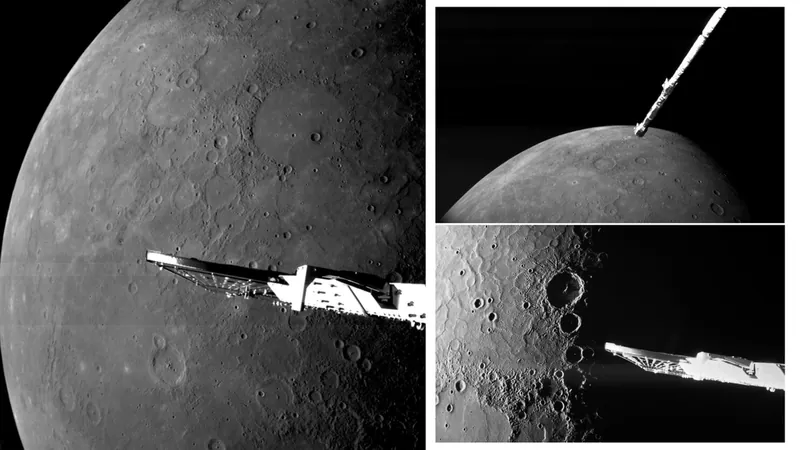
Incredible Images from BepiColombo's Final Flyby of Mercury That Will Blow Your Mind!
2025-01-09
Author: Amelia
The BepiColombo Mission
The BepiColombo spacecraft, a remarkable joint venture between the European Space Agency (ESA) and the Japan Aerospace Exploration Agency (JAXA), has just completed its sixth and final flyby of Mercury, the planet closest to the Sun. This thrilling milestone was achieved on January 8, 2024, at 00:59 EDT (0259 GMT), resulting in striking images that promise to unravel the mysteries of this enigmatic planet as we anticipate the spacecraft's eventual orbit insertion next year.
Launched on October 20, 2018, BepiColombo has been on a fascinating journey, using this final flyby, which took it within approximately 185 miles (295 kilometers) of Mercury’s darkened nightside, to gather critical data that will shape its mission. Seven minutes post-flyby, it cruised over Mercury’s north pole, and ESA Director General Josef Aschbacher wasted no time in showcasing the stunning visuals collected by the spacecraft’s monitoring cameras during the agency's Annual Press Briefing.
The significance of these six flybys cannot be overstated. "All six of its flybys of Mercury have provided invaluable insights into this little-explored planet," stated Geraint Jones, BepiColombo's Project Scientist at ESA. The actual mission phase is set to kick off with orbital insertion on November 21, 2026, but the data collected thus far continues to shed light on various facets of Mercury's geology and surface conditions.
Unraveling the Secrets of Mercury’s Surface
The breathtaking images reveal Mercury's surface as BepiColombo crossed the "terminator line," the border between the sunlit and dark halves of the planet. This particular perspective granted scientists an unprecedented view of Mercury’s perpetually shadowed craters, showcasing geological features like Prokofiev, Kandinsky, Tolkien, and Gordimer, whose depths potentially harbor water ice—one of the main focuses of future investigations.
Despite Mercury’s close proximity to the Sun, its surface is surprisingly dark, reflecting only about a third of the light that the Moon does. This low albedo is advantageous for researchers, as any brighter features on this otherwise dark canvas suggest geological processes at work, such as volcanic activity and impacts from celestial bodies.
Amongst the highlights is the Nathair Facula, marked by the largest known volcanic explosion on Mercury, encapsulating a vent about 25 miles (40 kilometers) wide. Not far from this feature is the Fonteyn impact crater, a relatively young structure formed around 300 million years ago, distinguished by its bright ejecta.
BepiColombo's exploration will delve deep into studying the composition of lava flows and impact ejecta, aiming to understand why the surface of Mercury darkens over geological time.
Witnessing the Awesomeness of Mercury’s Volcanic Plains
Images also captured the expansive volcanic plains of Borealis Planitia, formed approximately 3.7 billion years ago due to extensive lava flows. As the molten rock cooled, it caused the planet's surface to contract, leading to the formation of "wrinkles" visible in the mission’s images. Within this landscape lie the Henri and Lismer craters, now filled with hardened lava and surrounded by the remnants of more recent impacts.
One particularly intriguing feature noted in the data is a boomerang-shaped lava flow above the vast Caloris Basin, Mercury’s largest impact crater, which exceeds an impressive 930 miles (1,500 kilometers) in diameter. Scientists are eager to utilize the data from BepiColombo to determine the flow’s origin and relation to the Caloris basin.
As BepiColombo continues its groundbreaking mission, its findings hold the promise of answering long-standing questions about Mercury's surface and history. With the next flyby scheduled for December 1, 2024, the world eagerly awaits the revelations that will follow from this ambitious space mission.
Stay tuned for more explorations and mind-boggling discoveries from Mercury, as BepiColombo embarks on its quest to unlock the secrets of this fascinating planet!









 Brasil (PT)
Brasil (PT)
 Canada (EN)
Canada (EN)
 Chile (ES)
Chile (ES)
 Česko (CS)
Česko (CS)
 대한민국 (KO)
대한민국 (KO)
 España (ES)
España (ES)
 France (FR)
France (FR)
 Hong Kong (EN)
Hong Kong (EN)
 Italia (IT)
Italia (IT)
 日本 (JA)
日本 (JA)
 Magyarország (HU)
Magyarország (HU)
 Norge (NO)
Norge (NO)
 Polska (PL)
Polska (PL)
 Schweiz (DE)
Schweiz (DE)
 Singapore (EN)
Singapore (EN)
 Sverige (SV)
Sverige (SV)
 Suomi (FI)
Suomi (FI)
 Türkiye (TR)
Türkiye (TR)
 الإمارات العربية المتحدة (AR)
الإمارات العربية المتحدة (AR)